March 24, 2016
The Night Gardener and If I Had a Gryphon
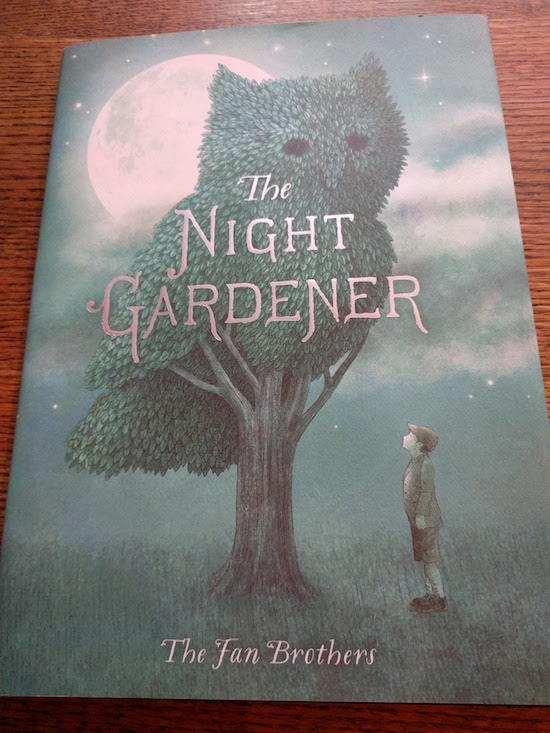 I wasn’t supposed to get a book at all, but then I ended up with two. These are the kinds of things that happen when one is me. The plan was to buy a book at Bakka Phoenix Books for Harriet’s friend who was moving away, but then I saw The Night Gardener by The Fan Brothers and also If I Had a Gryphon, by Vikki VanSickle and Cale Atkinson, and I had to have both of them.
I wasn’t supposed to get a book at all, but then I ended up with two. These are the kinds of things that happen when one is me. The plan was to buy a book at Bakka Phoenix Books for Harriet’s friend who was moving away, but then I saw The Night Gardener by The Fan Brothers and also If I Had a Gryphon, by Vikki VanSickle and Cale Atkinson, and I had to have both of them.
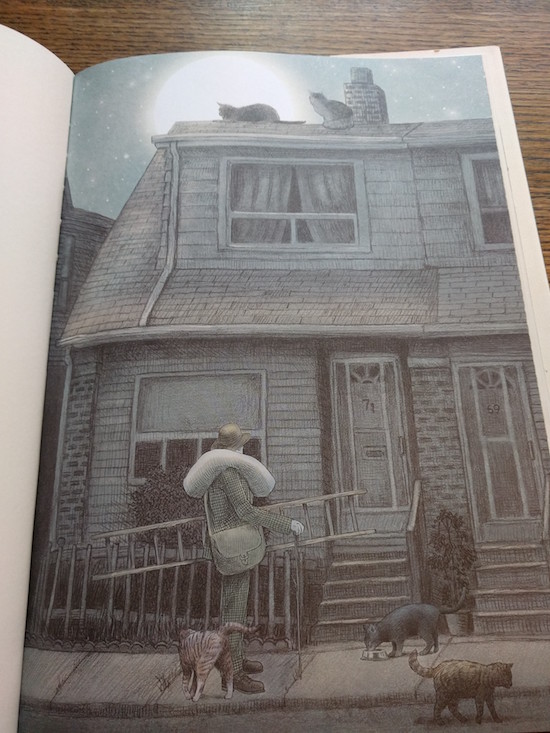
I have a weakness for books featuring Toronto-style houses (like Sidewalk Flowers, and another recent one I’ve seen is A Boy Asked the Wind), which is what drew me to The Night Gardener. Although I will admit to being confused to the story’s individual components: that the boy in the books lives in an orphanage, that the story exists outside of time that’s part Dickens, part contemporary; and there is something slightly sinister about the boy receiving a gift of a pair of secateurs. A lot of these concerns can be written off to magic, but it doesn’t seem entirely realized. What are realized, however, are the illustrations, ordinary trees reborn as creatures of all kinds, thanks to the work of a secret gardener who comes and goes in the night.
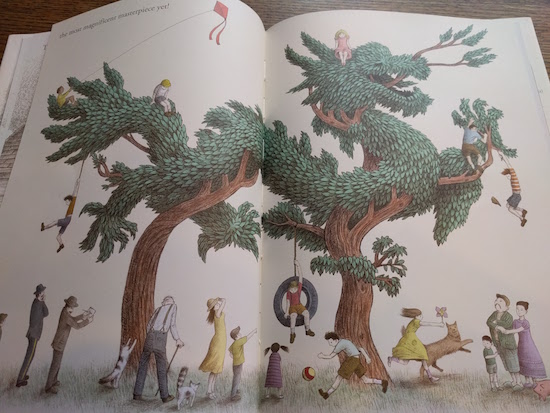 Anyway, the dragon in the above illustration brings me to If I Had a Gryphon, in which a small girl laments the mundanity of having a hamster for a pet. The book is written in rhyming verse featuring fun and playful illustrations, and we were immediately hooked.
Anyway, the dragon in the above illustration brings me to If I Had a Gryphon, in which a small girl laments the mundanity of having a hamster for a pet. The book is written in rhyming verse featuring fun and playful illustrations, and we were immediately hooked.
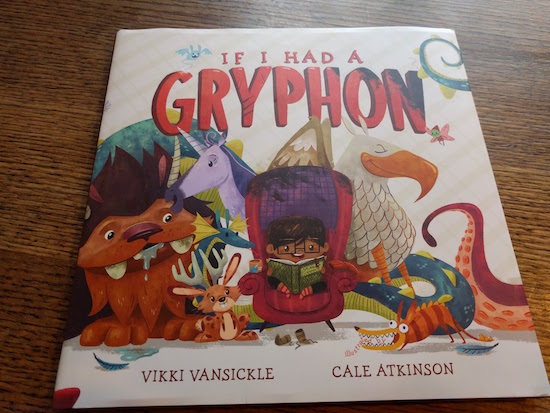
If I Had a Gryphon is a primer for future nerds, featuring allusions to a wide range of fictional creatures from myth and legend. Obviously, the little girl at its centre is a bookish one, and when she imagines alternatives to the hamster life, she’s not thinking ponies or cuddly kittens, but instead hippogriffs, sasquatches, or manticores.
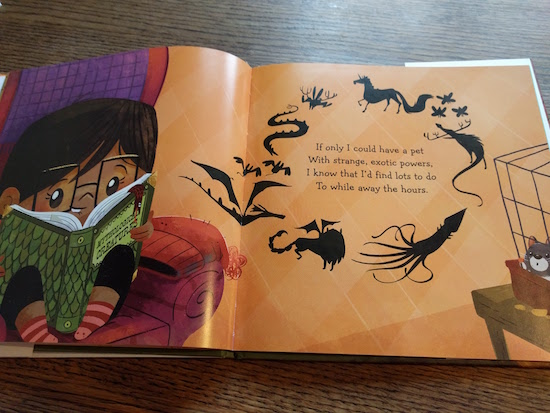
Thinking through her supposings, however, she realizes that mythical pets would actually be a lot of trouble (and that caring for them would probably cut into her time for reading).
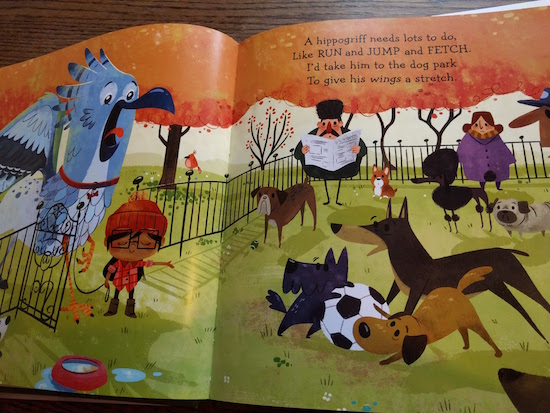
Clearly I’m not well read enough because many of the creatures in the book weren’t familiar to me: what is a kraken, after all, or a kiran, or a basilisk? Although such questions are the point I think, and this book serves as the perfect jumping off point for further exploration (as well as imaginary brand new, never-before-thought-of creatures). I don’t say this very often, but I think Gryphon might have benefited from a glossary to bring some of us up to mythical speed, although the internet will certainly suffice.
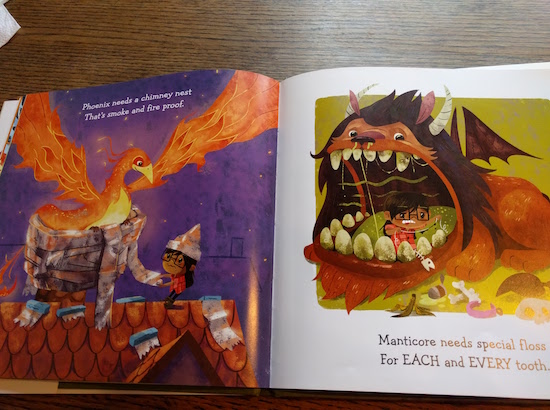
This book reminded of Julia’s House for Lost Creatures, by Ben Hatke, another picture book in which a tenacious girl has to contend with managing fictional beasts of all kinds. We love If I Had a Gryphon just as much, and every time we’ve read it, our delight in its final image has been absolutely. Just wait for it, and you’ll see what I mean.
March 22, 2016
Blogs to Watch
 Since writing about blogs and blogrolls last fall, I’ve returned to being avid about blog reading, using my Protopage reader to keep track of blogs I love and ever looking forward to updates. And happily, I’ve been adding new blogs to it, revelling in the writing and inspiration, in the serendipity of experience and connections made. Here are three to watch out for:
Since writing about blogs and blogrolls last fall, I’ve returned to being avid about blog reading, using my Protopage reader to keep track of blogs I love and ever looking forward to updates. And happily, I’ve been adding new blogs to it, revelling in the writing and inspiration, in the serendipity of experience and connections made. Here are three to watch out for:
- Homeward Odyssey, by Christine Nielsen: Christine was a student in my blogging course last fall, and I’m so pleased that she’s continued blogging into the new year. After years of travelling the world via her career in journalism, Christine is becoming preoccupied with notions of home. Her writing is wonderful, and each of her posts is its own journey, rich with twists and turns and unexpected astonishments.
- Creative Critique, by Margrit Talpalaru: I know Margrit from Twitter and her blog is brand new, and while usually I’d wait a bit to make sure a blog has legs before jumping on the bandwagon (for do you know how many abandoned blogs litter our internet?), I want to spread the word about this one in the hopes that an audience will inspire her to keep going. Posts so far are about hair and running, and they’re terrific.
- The Huron Playschool Blog: Our playschool has started a blog to increase the visibility of our website and our programs, and I am excited to be tasked with keeping it because our school has a really great history (nearly 50 years long) well linked with our city and amazing neighbourhood, as well as a great community and excellent programs, and it will be nothing short of fun to write about it all. Hope you’ll check in once in a while!
March 21, 2016
Malaika’s Costume and Maya
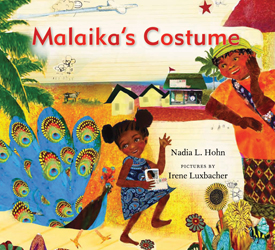 I recently had the pleasure of reviewing two absolutely beautiful picture books for Quill and Quire. Malaika’s Costume, by Nadia L. Holm and Irene Luxbacher, and Maya, by Mahakj Jain and Elly MacKay, are each exceptional books in their own right in terms of story and artwork, but when viewed together, all kinds of amazing connections occur, deepening the texture of both of them.
I recently had the pleasure of reviewing two absolutely beautiful picture books for Quill and Quire. Malaika’s Costume, by Nadia L. Holm and Irene Luxbacher, and Maya, by Mahakj Jain and Elly MacKay, are each exceptional books in their own right in terms of story and artwork, but when viewed together, all kinds of amazing connections occur, deepening the texture of both of them.
*****
From my review:
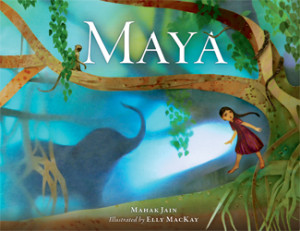 “It takes considerable talent for an illustrator to do justice to the peacock, to come even close to matching nature in rendering its most exquisite bird. With their textured and evocative illustrations in Malaika’s Costume and Maya, Irene Luxbacher and Elly MacKay, respectively, give nature a run for its money. Their images are the perfect backdrop for these deep and engaging stories about characters grappling with a parent’s absence…”
“It takes considerable talent for an illustrator to do justice to the peacock, to come even close to matching nature in rendering its most exquisite bird. With their textured and evocative illustrations in Malaika’s Costume and Maya, Irene Luxbacher and Elly MacKay, respectively, give nature a run for its money. Their images are the perfect backdrop for these deep and engaging stories about characters grappling with a parent’s absence…”
I hope you’ll read the whole thing here. This piece was such a joy to write.
March 20, 2016
Becoming Lin, by Tricia Dower
 Although coming-of-age books tend to feature adolescent protagonists, Tricia Dower’s novel Becoming Lin not only demonstrates that such “becomings” can occur elsewhere (and even more than once) in a lifetime, but also represents an arrival for the author herself. For this book, Dower’s third—after the acclaimed 2008 story collection Silent Girl, which put feminist spins on Shakespearean narratives; and the 2012 novel Stony River with its sinfully delicious Peyton Place bent—is absolutely her finest yet. Becoming Lin is the kind of book that you’re sorry when it’s finished, bereft to leave behind a world that has held you so fast.
Although coming-of-age books tend to feature adolescent protagonists, Tricia Dower’s novel Becoming Lin not only demonstrates that such “becomings” can occur elsewhere (and even more than once) in a lifetime, but also represents an arrival for the author herself. For this book, Dower’s third—after the acclaimed 2008 story collection Silent Girl, which put feminist spins on Shakespearean narratives; and the 2012 novel Stony River with its sinfully delicious Peyton Place bent—is absolutely her finest yet. Becoming Lin is the kind of book that you’re sorry when it’s finished, bereft to leave behind a world that has held you so fast.
It’s a novel about the 1960s, about idealism and reality, about the narrow confines of a wife’s identity and that of a mother. Familiar themes, all of these if you’ve read books like Margaret Laurence’s The Fire Dwellers or watched Mad Men, but themes made fresh with the nuances of the novel’s point of view, the carefulness with which these ideas are examined. In Becoming Lin, the prose is mostly inconspicuous, but what grips the reader is the evolution of Lin’s consciousness, and the complexity that arises from the absence of polarities—unusual for a history of a decade so constructed of extremes.
Linda Wise is sheltered, overprotected by her parents in their sleepy New Jersey town, particularly since her sexual assault years before (which occurred in the novel, Stony River). At the age of 23, she sees an opportunity for herself when she meets the charismatic Ron Brunson, a guest pastor at her family’s church one summer. Ron preaches social justice, and shares stories of his experiences on Freedom Rides, for which he spent time in jail. Ron’s values seem to accord with Linda’s own, but with the addition of the possibility of actual action, something she’s found hard-to-come-by in her hometown, studying at a women’s college toward a social work qualification. The two end up sitting side-by-side at a church dinner, and Dower marvellously constructs the dialogue that brings them even closer. Ron mentions to their table that his chances of getting a church of his own are lessened without a wife, who’s expected to take on (unpaid) roles in the congregation—among them counsellor or administrator-typist. Someone mentions he should put a wife-wanted ad in the newspaper, and Linda’s not quite listening to this.
“I type. I can do the bulletins,” she volunteers, with characteristic bad timing, in essence responding to the want-ad, and while the moment is awkward, Ron Brunson is game.
After a whirlwind courtship, they are married, and Linda (who is happy to have her new husband truncate her name to the more sophisticated-sounding “Lin”) follows Ron to his congregation far across the country to rural Minnesota, where she soon finds herself playing the careful and conservative role of the minister’s wife—not quite what she’d signed up for. Typing bulletins is not even the half of it. Most troublingly though is her husband’s reticence to voice his opposition to the Vietnam War, a point of view that could put his job at risk. And here is where a lesser novel would have irrevocably split the couple, wife going off to radical pursuits and leaving her dull husband behind, but instead Dower has Lin give Ron the courage to realize that opposing the war is his duty as a minister and as a Christian. Theirs is a true partnership, however much a complicated one.
And it is complicated, this we know from the outset, as chapters for the first half of Becoming Lin alternate between two timelines, one of the newlyweds negotiating their new life together, and the other of Lin half a decade later, now a mother to a young son with whom she is moving to the nearby city of Hopkins to begin a new life for herself. A temporary experiment, this is meant to be, though the reader is not made privy to the details at the outset—we know that she and Ron are still married, it’s his name on her apartment lease, that he takes for granted she’ll return home to a year from then. And the story here is familiar to me as well, because I grew up watching Three’s Company and One Day at the Time on television—sitcom scenes of single moms and apartment complex social dynamics. Though the problems Lin is grappling with here—and so too are the other single mom friends she encounters—are not so easily resolved in neat half hour episodes. It’s a brave new world of women’s lib, access to abortion, and career gals, though the notions of justice that have followed Lin throughout her life continue—she’s working for a company in which promotion is not accessible to women employees; her friends contend with deadbeat dads who don’t support their families, she gets groped on busses and feels somewhat unsafe just walking around in her own life.
In the intervening years, Lin and Ron had been wrapped up in the anti-war movement, stirring up resistance from their neighbours and gaining the unfortunate attention of the FBI. Her faith in God and religion has wavered, her husband’s remaining steadfast, and this has become a great divide between them. Their year apart then is an attempt to bridge that space, Ron wishing her to take the freedom and responsibility she longs for, and again, it’s a strength of the novel that he remains (for the most part) a sympathetic character, their connection a true one, albeit one with weak spots and failings. And that the religious character (he’s such a square, man!) does not become the bad guy, that he too is on the side of social justice, but his position is complicated too, just like life is.
In essence, Lin has two becomings in this story, and it’s important to note that one is not necessarily the undoing of the other. That progress is a process, and so is it for feminism, coming in waves as it does, some change rolling back on other kinds, and there is contradiction and disagreement, which might look like disarray from a distance, but it’s a becoming, indeed.
March 18, 2016
A New Canadian

One of the responsibilities of Canadian citizenship is that one takes care of one’s family, so it’s kind of fitting that Stuart missed his call to take the citizenship oath last month because he was taking care of his sick child all night long. He had to write a letter explaining the situation and requesting another date, which was today. And this time we actually made it. It was really, really lovely, 100 people from places all over the world having taken so many steps to get here—to choose Canada. (It not lost on me too that Stuart choosing Canada means that Stuart chose me; lucky, lucky me.)

For the past 10.5 years, Stuart has been doing all the things that good Canadians do—learning to skate and not even calling it ice-skate; rolling up rims; working hard and paying taxes (and receiving all the benefits that go with that, of course); shovelling snow; raising little Canadians; celebrating July 1sts; listening to the CBC; swimming in lakes; volunteering in his community; reading Canadian books; drinking Canadian beer; embracing summer long weekends; watching Heritage Minutes; talking about Drake; and rocking out to the Guess Who. As soon as our local grocery store can get it in stock, no doubt he’ll be buying crates of French’s ketchup.
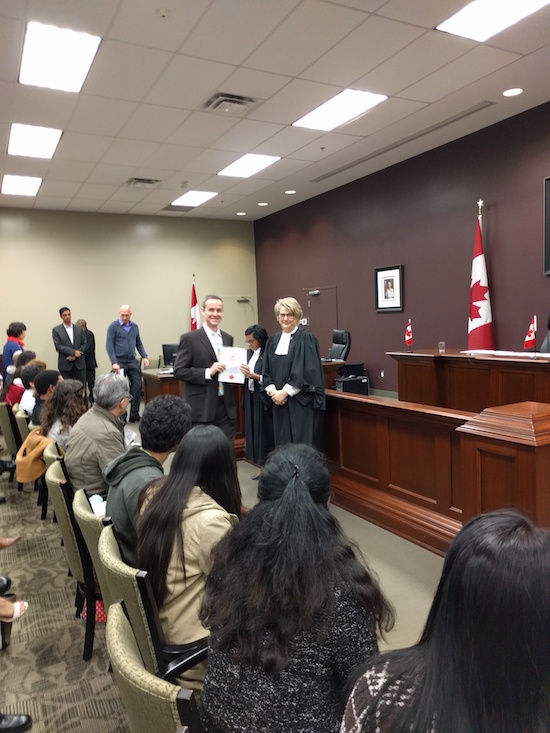
“You all come from places that make beautiful art,” the citizenship judge told the new Canadians assembled, encouraging them to share that art with the rest of us, whether it’s art they create or art they’ve brought with them. “What I’m saying is, Turn Your Music Up,” she told us. (Respectful British-Canadians might sit one this out, perhaps, having shared quite enough with Canada over the centuries, if by “shared” you mean “stolen,” but alas. Though we do appreciate the Beatles.) “It makes the fabric of our nation so much better.” Since October 19, I’ve actually been a little bit proud to be a Canadian again, and I would have even sung “Oh, Canada” today along with Stuart and all our other newly fellow-Canadians, but I couldn’t because I was crying too much.
March 17, 2016
Barbados Book Report
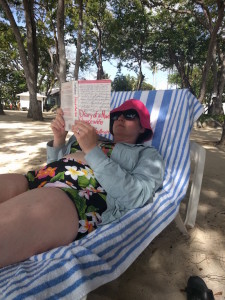 I promise that I am nearly finished writing blog posts about Barbados, but I haven’t talked about the books yet. We brought so many books to Barbados, twelve or so, books for me and books for Stuart, and it made our suitcase quite heavy and wondered if it was really wise to travel with more books than sunscreen, but my intuition than it was indeed turned out to be correct. Because there was so much time to read, and even enough time that there was enough time to read…and also do other things besides reading. (I am also not sorry that we brought twelve physical books with us, a few of them hardcovers, because on the journey home I found a forgotten Kindle in the pocket of the seat in front of me, belonging to someone called Pat who’d lost more than 100 books all that once. If I’d forgotten a book in an airplane [which, by the way, would never ever ever happen] I’d still have eleven more available for my reading pleasure. There is nothing I’d rather carry more than books. And I would rather carry books than nothing any time.)
I promise that I am nearly finished writing blog posts about Barbados, but I haven’t talked about the books yet. We brought so many books to Barbados, twelve or so, books for me and books for Stuart, and it made our suitcase quite heavy and wondered if it was really wise to travel with more books than sunscreen, but my intuition than it was indeed turned out to be correct. Because there was so much time to read, and even enough time that there was enough time to read…and also do other things besides reading. (I am also not sorry that we brought twelve physical books with us, a few of them hardcovers, because on the journey home I found a forgotten Kindle in the pocket of the seat in front of me, belonging to someone called Pat who’d lost more than 100 books all that once. If I’d forgotten a book in an airplane [which, by the way, would never ever ever happen] I’d still have eleven more available for my reading pleasure. There is nothing I’d rather carry more than books. And I would rather carry books than nothing any time.)
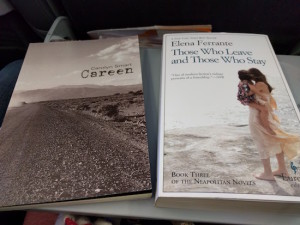 My first book was Those Who Leave and Those Who Stay, the third book in Elena Ferrante’s Neapolitan novels series. As I’ve said, it’s a series I’m not mad for, but am intrigued by, and I’ve enjoyed each subsequent book more than the previous (which makes sense—I’m perpetually bored by stories of childhood and adolescence). And this was the one I’ve been most looking forward to, for the characters are mothers now and Lena is a writer, and these storylines compel me. And they did. I read most of this on the 5 hour flight, dipping in and out of Carolyn Smart’s collection of Bonnie and Clyde poems, Careen, for diversion. I enjoyed it so much, and was most struck by the tension between the two friends when Lena becomes pregnant and is determined to do pregnancy and motherhood properly, to prove her friend’s struggles with it had been personal failings rather than circumstance. And there are even a few days where it seems possible, until the whole thing goes to pieces, and she loses herself as so many women do (not knowing too that all this is such a temporary situation—she imagines motherhood as a fixed state). This was the first Ferrante books I seemingly devoured in that way one is meant to. I really really liked it.
My first book was Those Who Leave and Those Who Stay, the third book in Elena Ferrante’s Neapolitan novels series. As I’ve said, it’s a series I’m not mad for, but am intrigued by, and I’ve enjoyed each subsequent book more than the previous (which makes sense—I’m perpetually bored by stories of childhood and adolescence). And this was the one I’ve been most looking forward to, for the characters are mothers now and Lena is a writer, and these storylines compel me. And they did. I read most of this on the 5 hour flight, dipping in and out of Carolyn Smart’s collection of Bonnie and Clyde poems, Careen, for diversion. I enjoyed it so much, and was most struck by the tension between the two friends when Lena becomes pregnant and is determined to do pregnancy and motherhood properly, to prove her friend’s struggles with it had been personal failings rather than circumstance. And there are even a few days where it seems possible, until the whole thing goes to pieces, and she loses herself as so many women do (not knowing too that all this is such a temporary situation—she imagines motherhood as a fixed state). This was the first Ferrante books I seemingly devoured in that way one is meant to. I really really liked it.
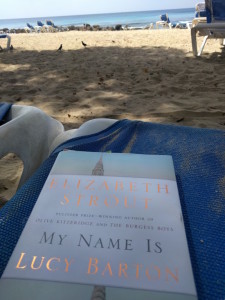 Next up was My Name is Lucy Barton, by Elizabeth Strout, which Ann Patchett and others had proclaimed as Strout’s best book yet. I’d come belatedly to Olive Kitteridge, but really liked it, and had been looking forward to this one, but it kind of disappointed me. I mean not entirely, because it was interesting and also short, a consideration which meant my investment was not overwhelming. But this was also problematic because I bought the book in hardback, paid $30+ for it and felt I’d paid a lot of money for something slight and unfinished. Which was inherent to the project, I supposed, but I was never able to quite figure out how, or what the point was, or why this wasn’t a novel proper. Though it being short, I think I will go back and explore it again, see what I missed. It did actually seem an uncanny read after reading Ferrante, echoes of one with the other. The very premise of Lucy Barton reminded me of the part in The Story of a New Name in which Lena’s mother comes to Pisa to care for her when she is ill, an anomaly in the story of their relationship, as it was for Lucy and her mother, and so too the circumstance of each woman’s positioning against her past and her family, and the insurmountable nature of class.
Next up was My Name is Lucy Barton, by Elizabeth Strout, which Ann Patchett and others had proclaimed as Strout’s best book yet. I’d come belatedly to Olive Kitteridge, but really liked it, and had been looking forward to this one, but it kind of disappointed me. I mean not entirely, because it was interesting and also short, a consideration which meant my investment was not overwhelming. But this was also problematic because I bought the book in hardback, paid $30+ for it and felt I’d paid a lot of money for something slight and unfinished. Which was inherent to the project, I supposed, but I was never able to quite figure out how, or what the point was, or why this wasn’t a novel proper. Though it being short, I think I will go back and explore it again, see what I missed. It did actually seem an uncanny read after reading Ferrante, echoes of one with the other. The very premise of Lucy Barton reminded me of the part in The Story of a New Name in which Lena’s mother comes to Pisa to care for her when she is ill, an anomaly in the story of their relationship, as it was for Lucy and her mother, and so too the circumstance of each woman’s positioning against her past and her family, and the insurmountable nature of class.
 After that, I read The Sunken Cathedral, by Kate Walbert, whose A Short History of Women I’d enjoyed so much a few years ago, and it came recommended by Nancy Jo at Book City. It also seemed like a strange choice following My Name is Lucy Barton, also set in New York City, delving into ideas of motherhood, art, and friendship. Although I felt I wasn’t quite in the right mindset for it. It’s even more fragmented than Lucy Barton but less annoying so—the pieces are so disparate that it makes the project seem like more instead of less. All the same though, I couldn’t make the pieces (each of them compelling in their own rights) fit together to mean something greater than the parts. Was I reading it wrong, I wondered? Why couldn’t I focus enough to have the whole thing make sense? And then I found this New York Times book review that kind of confirmed by feelings and suggesting the problem wasn’t entirely me, and I liked the book better after that, accepting it on its own terms.
After that, I read The Sunken Cathedral, by Kate Walbert, whose A Short History of Women I’d enjoyed so much a few years ago, and it came recommended by Nancy Jo at Book City. It also seemed like a strange choice following My Name is Lucy Barton, also set in New York City, delving into ideas of motherhood, art, and friendship. Although I felt I wasn’t quite in the right mindset for it. It’s even more fragmented than Lucy Barton but less annoying so—the pieces are so disparate that it makes the project seem like more instead of less. All the same though, I couldn’t make the pieces (each of them compelling in their own rights) fit together to mean something greater than the parts. Was I reading it wrong, I wondered? Why couldn’t I focus enough to have the whole thing make sense? And then I found this New York Times book review that kind of confirmed by feelings and suggesting the problem wasn’t entirely me, and I liked the book better after that, accepting it on its own terms.
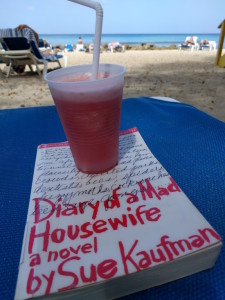 And then I read Diary of a Mad Housewife, which I was absolutely mad for. I’d ordered it after reading Laura Miller’s article on the resurgence of the housewife novel, which interested me because I think Mitzi Bytes fits into the genre. And it was fantastic. How can this book be out of print? It’s funny, sharp, and a marvellous exercise in narrative voice. I’ve never seen the award-winning film, but now I’d like to. As the introduction indicated in my edition, this 1967 anticipated books like Bridget Jones Diary and Candice Bushnall’s Sex and the City columns, and fits well into the genre of Betty Draper books I kind of love, which includes Margaret Laurence’s The Fire Dwellers, The Torontonians by Phyllis Brett Young, and the obligatory Betty Friedan. I appreciate that it’s a book about marriage and motherhood that does necessarily think marriage or motherhood is the singular problem, but that the problems go deeper than that. Also seemed an extension of The Sunken Cathedral in its considerations of New York and motherhood. These novels were continuing to speak to one another.
And then I read Diary of a Mad Housewife, which I was absolutely mad for. I’d ordered it after reading Laura Miller’s article on the resurgence of the housewife novel, which interested me because I think Mitzi Bytes fits into the genre. And it was fantastic. How can this book be out of print? It’s funny, sharp, and a marvellous exercise in narrative voice. I’ve never seen the award-winning film, but now I’d like to. As the introduction indicated in my edition, this 1967 anticipated books like Bridget Jones Diary and Candice Bushnall’s Sex and the City columns, and fits well into the genre of Betty Draper books I kind of love, which includes Margaret Laurence’s The Fire Dwellers, The Torontonians by Phyllis Brett Young, and the obligatory Betty Friedan. I appreciate that it’s a book about marriage and motherhood that does necessarily think marriage or motherhood is the singular problem, but that the problems go deeper than that. Also seemed an extension of The Sunken Cathedral in its considerations of New York and motherhood. These novels were continuing to speak to one another.
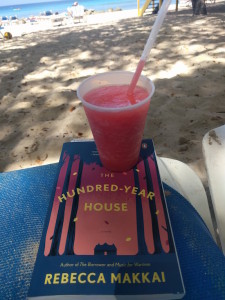 Following that, I read The Hundred Year House, by Rebecca Mekkai, which is our book club selection for this month and as I’d read online that it was a bit of a beach read, it seemed fitting to bring with us. It was a strange book that I didn’t entirely understand until I was further into it, and also not until I’d read about her first novel, The Borrower, which was rich with references to classic children’s books including The Westing Game, by Ellen Raskin, and the suddenly it all made sense, that this book is similarly a puzzle mystery but for grown-ups. The story moves backwards over the twentieth century to reveal the secrets behind a house, the eccentric family that owned it, and the visitors at an artists’ colony housed there for several decades. On the whole, it was a bit forgettable, but I enjoyed it. Curious echoes between it and Mad Housewife as well—both have characters who are hit in the face by mean men called George.
Following that, I read The Hundred Year House, by Rebecca Mekkai, which is our book club selection for this month and as I’d read online that it was a bit of a beach read, it seemed fitting to bring with us. It was a strange book that I didn’t entirely understand until I was further into it, and also not until I’d read about her first novel, The Borrower, which was rich with references to classic children’s books including The Westing Game, by Ellen Raskin, and the suddenly it all made sense, that this book is similarly a puzzle mystery but for grown-ups. The story moves backwards over the twentieth century to reveal the secrets behind a house, the eccentric family that owned it, and the visitors at an artists’ colony housed there for several decades. On the whole, it was a bit forgettable, but I enjoyed it. Curious echoes between it and Mad Housewife as well—both have characters who are hit in the face by mean men called George.
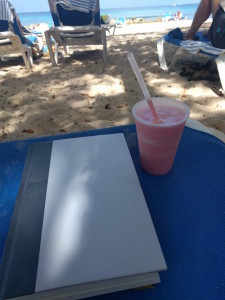 I had to take the dust jacket off for the next book, because my friend loaned it to me and then I took it to the beach, which puts books in perilous situations. The book is The Faithful Place, by Tana French, whose books I adore. My third Tana French, and perhaps my favourite. (I am reading them in order; each book is narrated by a minor character from the previous one. And I was so thrilled to discover a new one is forthcoming in August!) I don’t recall connections between this one and others I was reading, but I was so entirely absorbed in the novel that I wasn’t thinking about anything else. It’s about a Dublin detective, Frank Mackey, who returns to his estranged family when a suitcase is discovered in an abandoned house on their street. The suitcase belongs to his first love, a girl who jilted him on the night they were meant to run away together. And now maybe it turns out that he wasn’t jilted, and that someone close to both of them actually killed her.
I had to take the dust jacket off for the next book, because my friend loaned it to me and then I took it to the beach, which puts books in perilous situations. The book is The Faithful Place, by Tana French, whose books I adore. My third Tana French, and perhaps my favourite. (I am reading them in order; each book is narrated by a minor character from the previous one. And I was so thrilled to discover a new one is forthcoming in August!) I don’t recall connections between this one and others I was reading, but I was so entirely absorbed in the novel that I wasn’t thinking about anything else. It’s about a Dublin detective, Frank Mackey, who returns to his estranged family when a suitcase is discovered in an abandoned house on their street. The suitcase belongs to his first love, a girl who jilted him on the night they were meant to run away together. And now maybe it turns out that he wasn’t jilted, and that someone close to both of them actually killed her.
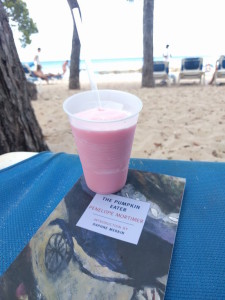 The Pumpkin Eater, by Penelope Mortimer, was after that, the fourth book I’ve read by Mortimer, although it reminded me much more of Our Spoons Came From Woolworths, by Barbara Comyns, in being a rather devastated telling of the realities behind fancy bohemian lives. These poor women. (Both novels are autobiographical as well.) It’s about a wife who has been as partial to philandering as she is to bearing children, but when her umpteenth husband starts cheating on her, it’s all quite different. It’s a spare novel, much of it dialogue and we don’t even know the main character’s name. I didn’t enjoy it as much as I’ve enjoyed later novels by Mortimer—I liked My Friend Says It’s Bullet-Proof and Home, novels written after this one and Daddy’s Gone a Hunting. But I also think it’s far from a beach read and one perhaps not best appreciated under the influence of a daiquiri. And so I’m going to be reading it again.
The Pumpkin Eater, by Penelope Mortimer, was after that, the fourth book I’ve read by Mortimer, although it reminded me much more of Our Spoons Came From Woolworths, by Barbara Comyns, in being a rather devastated telling of the realities behind fancy bohemian lives. These poor women. (Both novels are autobiographical as well.) It’s about a wife who has been as partial to philandering as she is to bearing children, but when her umpteenth husband starts cheating on her, it’s all quite different. It’s a spare novel, much of it dialogue and we don’t even know the main character’s name. I didn’t enjoy it as much as I’ve enjoyed later novels by Mortimer—I liked My Friend Says It’s Bullet-Proof and Home, novels written after this one and Daddy’s Gone a Hunting. But I also think it’s far from a beach read and one perhaps not best appreciated under the influence of a daiquiri. And so I’m going to be reading it again.
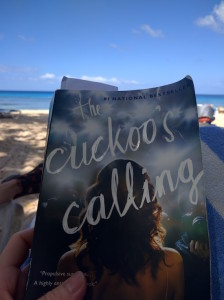 And finally, my bonus book (for it was from Stuart’s stack). The Cuckoo’s Calling, by Robert Galbraith i.e. J.K. Rowling, her foray into detective fiction, the first in a trilogy. And I loved it. For me, I’ve always connected J.K. Rowling (whose work I’ve not read before, apart from a read aloud of the first Harry Potter a couple of years ago) with Kate Atkinson, both of their career successes undertaking similar trajectories, and so it seemed fitting that this book reminded me so much of Atkinson’s Jackson Brodie novels (although Galbraith’s is much lighter in tone, less brutal and violent). Anyway, The Cuckoo’s Calling was great, and I look forward to following its characters through the other books in the series.
And finally, my bonus book (for it was from Stuart’s stack). The Cuckoo’s Calling, by Robert Galbraith i.e. J.K. Rowling, her foray into detective fiction, the first in a trilogy. And I loved it. For me, I’ve always connected J.K. Rowling (whose work I’ve not read before, apart from a read aloud of the first Harry Potter a couple of years ago) with Kate Atkinson, both of their career successes undertaking similar trajectories, and so it seemed fitting that this book reminded me so much of Atkinson’s Jackson Brodie novels (although Galbraith’s is much lighter in tone, less brutal and violent). Anyway, The Cuckoo’s Calling was great, and I look forward to following its characters through the other books in the series.
Since returning, I’ve been immersed in great Spring 2016 books, and I have a few really good ones I look forward to telling you about.
March 15, 2016
If you wanna be my lover, you gotta get with my friends
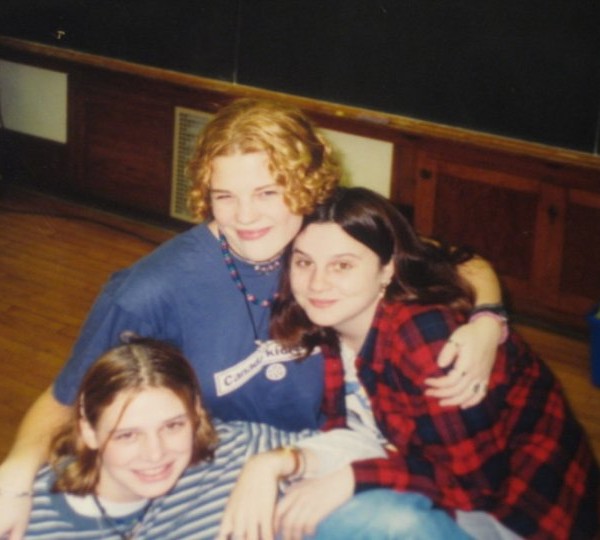
My friends at Plenty are talking about friendship throughout March, and I was pleased to contribute an essay I wrote about my nearly 25-year-old relationship with my best friends, Britt and Jennie (pictured above in Grade 10 French class, I think). I wrote about how with friendships that old, you eventually have a million things to apologize for, and also about how the Spice Girls taught us how a person should be, how our boyfriends were quite disposable, and how (in a numerical feat as remarkable as “2 Become 1”) 3 becomes 12.
March 13, 2016
We did it.
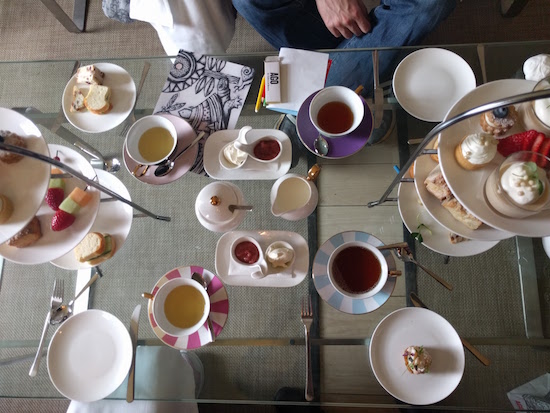
“WE DID IT. WE FUCKING MADE IT. AND LOOK AT HOW AMAZING THESE GIRLS ARE? LOOK AT HOW MIRACULOUS AND INTERESTING AND SMART AND FUNNY AND WILD AND BRILLIANT THESE BABES BE!? AND SOME DAYS ARE REALLY FUCKING HARD. AND SOME DAYS ARE REALLY FUCKING BEAUTIFUL. AND ALL OF THE DAYS… EVERY SINGLE ONE OF THEM ARE WORTH IT. THEY HAVE ALWAYS BEEN WORTH IT.” —Rebecca Woolf, Girl’s Gone Child
I never had twins (thank goodness; one baby at a time absolutely pushed me to my limits) but the post from which I quote above really resonated with me. Iris turns two-and-three-quarters next month, which means her third birthday’s on the horizon, and we’ve recently given up diapers, some days we don’t need a nap, she (usually) behaves perfectly well in a restaurant, and today we all went out for afternoon tea. For no occasion, and yet it seems like all the occasions—my novel is finished and gone into copyedits; Stuart (hopefully!) becomes Canadian next week; it’s March Break; how doesn’t like celebrating return from a tropical locale with a lavish lunch. And because Iris is finally old enough to partake. We’re about to leave the baby years behind us, and I can’t think of a better reason to celebrate than that, the future unfolding as it should.
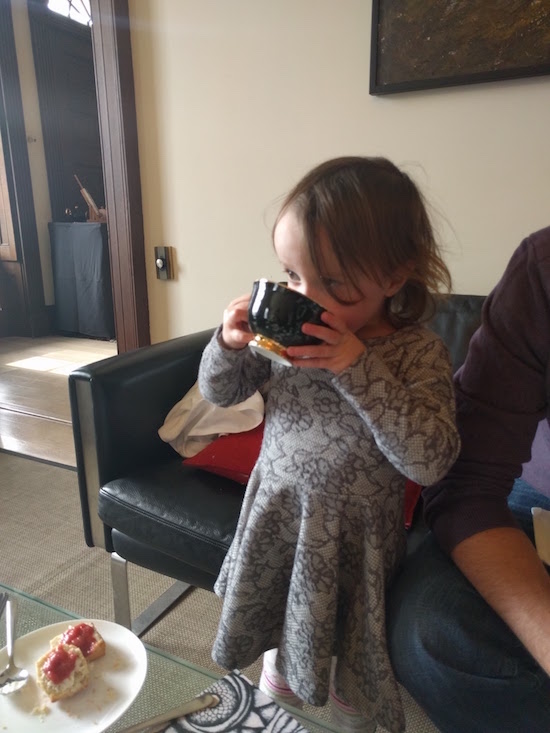
We never could have dreamed up Iris—she’s a full fledged mould breaker, hilarious, mischievous, irascible, loving, kind, silly and always paying attention. If you ask her anything, she’ll answer you: “Pooks.” We don’t know what pooks is, the definition ever-shifting, whatever is convenient to hang it on. She loves her sister, reading Go Dog Go and talking about nipples. She likes exclaiming, “Goodness gracious,” when she’s not saying, “Pooks.” She knows more about immigration than most two-year-olds: “Daddy’s going to be a Canadian,” she says. “I’m a Canadian already.” She is a favourite pet of Harriet’s classmates and happily ensconced in a class of her own at playschool, where she plays in drama, paints pictures, learns songs and stories. Her favourite thing is singing Twinkle Twinkle Little Star. She still likes to climb up onto the table and jump up and down. If she’s hungry, she can be trusted to go fetch a snack, no matter how (seemingly) unattainable that snack might be. She likes reading picture books and gets annoyed when we read books without pictures, goes and throws toys on the floor to get our attention. When she does something wrong, most of the time she is willing to say sorry, but always follows up her apology by asking, “And you say, ‘It okay, Iris,’ okay?”

Harriet will very soon be six-and-three-quarters, which was the age I was at when I discovered there was such a thing as fractions. She will forever to us seem old and wise, just as Iris is forever little, and part of the pleasure I take in the prospect of Iris’s third year was all the fun we had the summer that Harriet was that age, when all at once the days were longer and the world was bigger and we could do almost anything. But she was so little then, I realize now, particularly compared to where she is today. She is bright and articulate and forthright and ambitious, and imagines that she can make anything at all. When she grows up, she wants to be a scientist or a rock star, although she’s leaning toward the former. She loves Taylor Swift, and dancing, and identifies as a feminist. Yesterday we were at Value Village sorting through t-shirts, and I held up one that said, “Girls Rock.” “Okay,” she said. “I mean, it’s what I believe.” She is strong and brave and loves heroic tales of awesome girls. Though she also loves Archie Comics and Betty and Veronica, so she contains multitudes. She’s nuts about the Amulet series, the Narnia books (when girls are in the story), is still more partial to graphic novels than novels proper, and is determined to invent a series of feminist superheroes who do not necessarily fight for justice in their underpants.
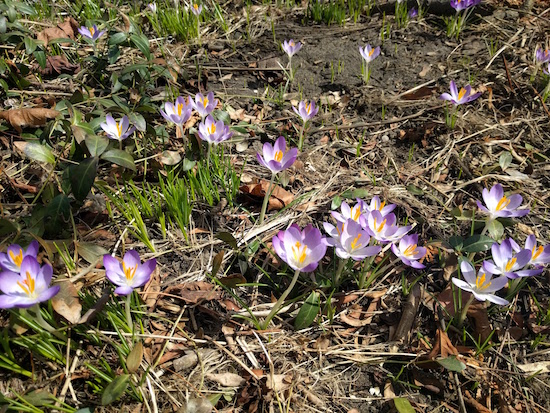
We went shopping yesterday, because what better way to mark the explosion of crocuses across the street than buying shoes for our children’s ever growing feet. It was our biannual expedition to the world of commerce, with purchases of nightgowns too and suburban dinner at chain restaurant (with Jello for dessert!), always a big occasion—we get to drive in a car and everything. Plus a stop at Value Village for amazing clothes for growing girls, which was really an excuse to go on a mug-hunt, but the pickings were slim in the kitchenware dept. Alas. We got what we went for though, and I will never cease to be grateful that we can afford shoes for our children—rain-boots, sneakers and sandals too, which is a small bundle. I can’t imagine how hard it would be to have to struggle for that, but nor can I imagine how we got here after all—to be grown people who buy small children tiny new shoes year after year, though they become less tiny with every season.
March 11, 2016
Going for a Sea Bath, by Andrée Poulin and Anne-Claire Delisle
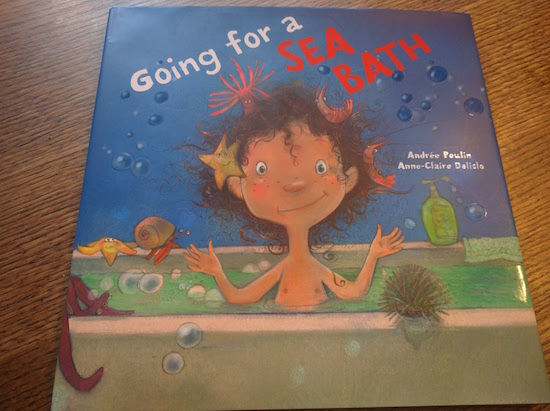
After a week sitting beside the ocean, it was a pleasure to return home to brand new book Going For a Sea Bath, by Andrée Poulin and Anne-Claire Delisle, and translated from French by Erin Woods. Although I’ll admit to being initially a bit wary of the book—as an avid reader of classic Canadian bath-lit, I’d noted a resemblance in substance and style to Eugenie Fernandes’ Waves in the Bathtub. But I was happy to find out that the resemblance is only skin deep, and while both titles make for excellent companion readers, Going for a Sea Bath is something all its own.
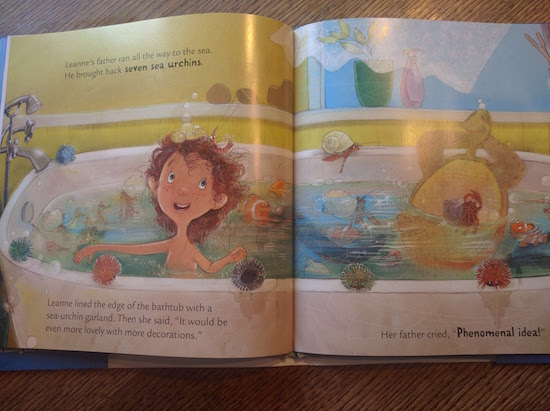
In terms of structure, pacing and general silliness, Going for a Sea Bath recalls early-Munsch. It’s the story of a little girl called Leanne who finds bath time too boring, and so her doting father runs down to the sea to find her creatures to liven up the tub. Beginning with a turtle, and moving onto eels, and anemones, urchins and clownfish, with eventually the marine menagerie becoming too much to handle—leading to the inevitable addition of octopi.
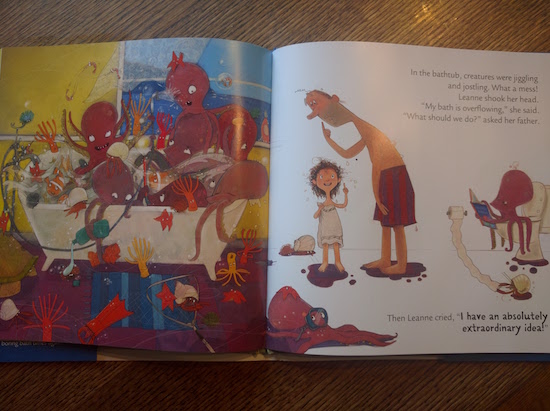
And by this point things are absolutely overflowing, but Leanne’s dad is not deterred. The page above, for obvious reasons (i.e. an octopus on the toilet, a hermit crab with toilet paper!—these perfect details in the illustrations feature throughout) is a favourite in our house, the point at which everything is totally out of control, and Leanne’s dad proposes they forego the bath altogether and jump into the sea, which is the most fun bath of all.
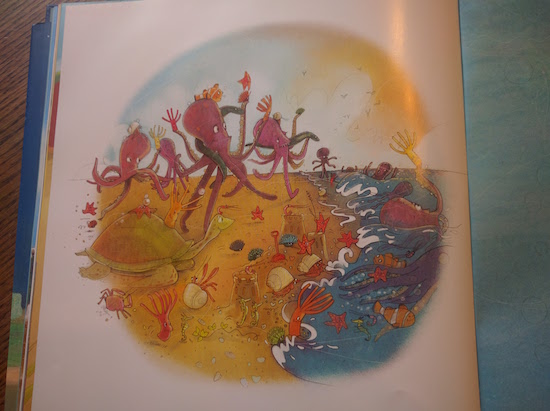
March 9, 2016
Barbados in Words, Part II

I think photos say it better though. Mostly because we really didn’t do much—you’ll notice that I took very few photos that weren’t from the vantage point of a beach lounger. By the end, we were getting bored (and sick of eating), which was kind of the point. To be bored—what a luxury. Also, to read an entire book every single day. But really, speaking of luxury, best of all was the time together, just the two of us. We haven’t spent a week without our children ever since they were born, and we’ve never been to an all-inclusive resort, or to the Caribbean. The closest we’ve ever come to a beach vacation was our time in Northern Thailand building a house for Habitat for Humanity, which had no beach and involved mixing cement by hand and brick-laying (which, incidentally, I’m not very good at, in case you were wondering). So this trip to Barbados was precedent setting. And probably mostly once in a lifetime. But how cool that that happened last week.

Our tenth anniversary was last June, and we might have gone away then except that Iris was too small and we wanted to go to England before she turned two (and therefore required a seat purchase). So it was put off until this year, which was fine because how nice to be still celebrating our anniversary nine months later. And none of it could happened without my wonderful mom who came and took excellent care of our daughters so that we didn’t worry about them ever, ever. (“Was it difficult to adjust to being away without then?””Well…no.”) And so we two had a week in paradise where the weather was always always perfect, where nobody had to cook or make school lunches, and we could sit with just us at the table—except for the time our breakfast was interrupted by a monkey.

In Barbados, there are trees on the beach, which didn’t prevent me from breaking out in a terribly rash from my sun allergy, but I didn’t care because I was sitting under a tree on the beach. Where the water was so magically blue, and I was either reading or swimming, and the sea was so warm and we floated in the saltwater with incredible ease—nothing has ever been more relaxing. Sometimes, to break up the day, we sat upright, but not very often. We drank rum punch, pina coladas, and daiquiris before lunchtime. I ate friend plantains for breakfast every day until I was tired of them. Our beach was a five minute walk from the town of Speightstown, which gave us a glimpse of a Barbados a little more real than our resort afforded, and also the most amazing bakery and sea views at the Fisherman’s Pub. And there were so many hours in the day, it seemed unfathomable. To read an entire book, and still have a few hours free? What an amazing indulgence. Every day the sun went down around 6pm and we made a point of marking the occasion…with another drink.






